The capybara is a fascinating animal that has captured the attention of many nature enthusiasts. Known scientifically as Hydrochoerus hydrochaeris, it holds the title of the world’s largest rodent.
Its unique appearance and intriguing behaviors make it a captivating creature to observe. Capybaras are social animals that live in groups, typically near water.
They are excellent swimmers and often use their aquatic abilities to evade predators.
This article will uncover the mysteries of the world’s most amiable mammal, the capybara. Let’s get started!
Physical Characteristics of Capybaras
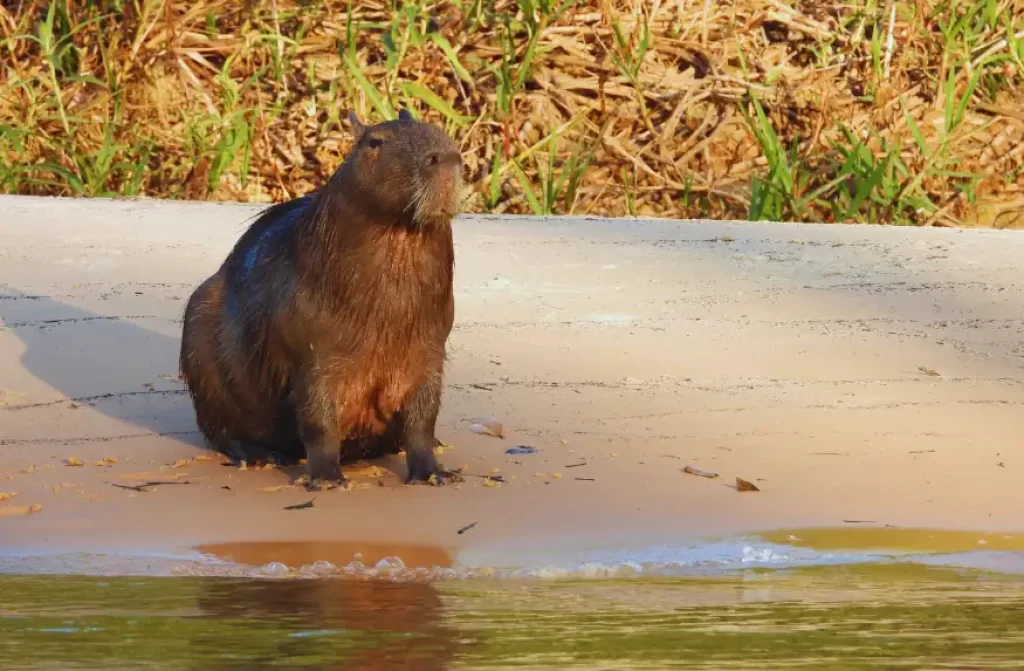
Capybaras have a stout and robust body, resembling a giant guinea pig or a barrel-shaped rodent. They have short, sturdy limbs and a slightly arched back.
Body Shape and Fur
Capybaras have a stout and robust body, similar to a well-built person’s. Their physique can be compared to a larger version of a guinea pig or even a barrel-shaped human. A solid build and a sense of strength characterize their body shape.
When it comes to their fur, capybaras display a fascinating coloration pattern. The upper part of their body is covered in reddish-brown fur, while the fur underneath takes on a lovely yellowish-brown shade.
This contrast of colors gives them a distinctive and attractive appearance, much like a person with unique and eye-catching hair colors.
Unlike most rodents, capybaras do not have a specific type of hair called down hair, much like how some individuals might have a different hair texture.
Additionally, their guard hair, which serves as their primary protective layer, does not significantly differ from the rest of their hair.
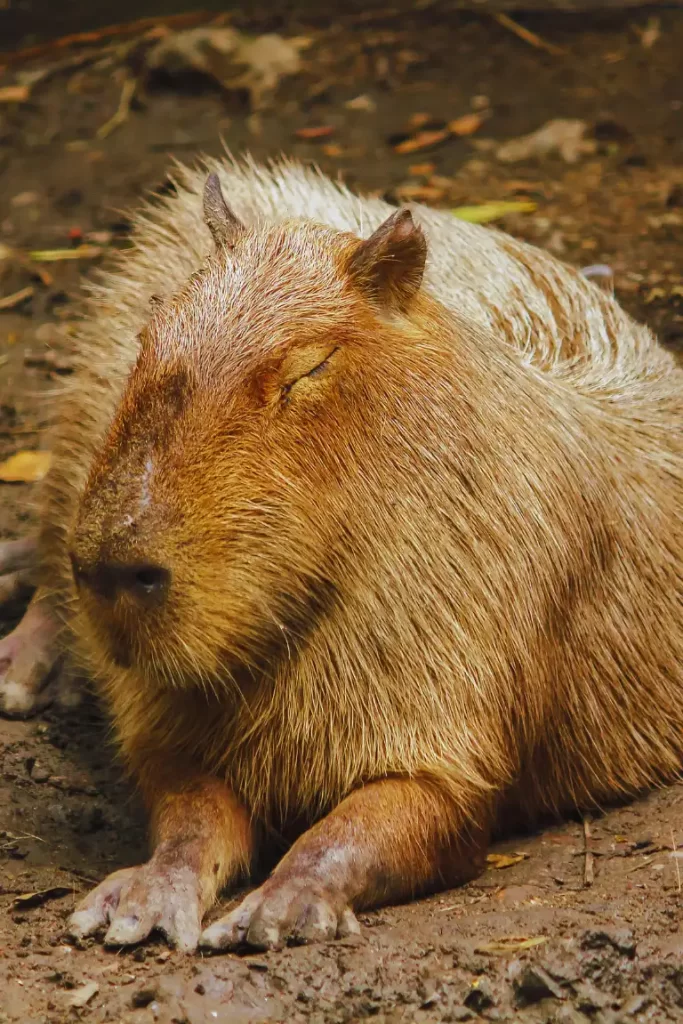
This similarity can be compared to how human hair often has consistent thickness and texture throughout. This feature sets capybaras apart from other rodents, just as certain traits make each person unique.
Another interesting human-like characteristic of capybaras is the presence of sweat glands in their hairy skin. While most rodents lack sweat glands, capybaras can regulate their body temperature through perspiration, similar to how humans sweat to cool themselves down.
This ability allows capybaras to adapt to different environments, much like how humans have developed mechanisms to cope with various climates and conditions.
Size and Weight
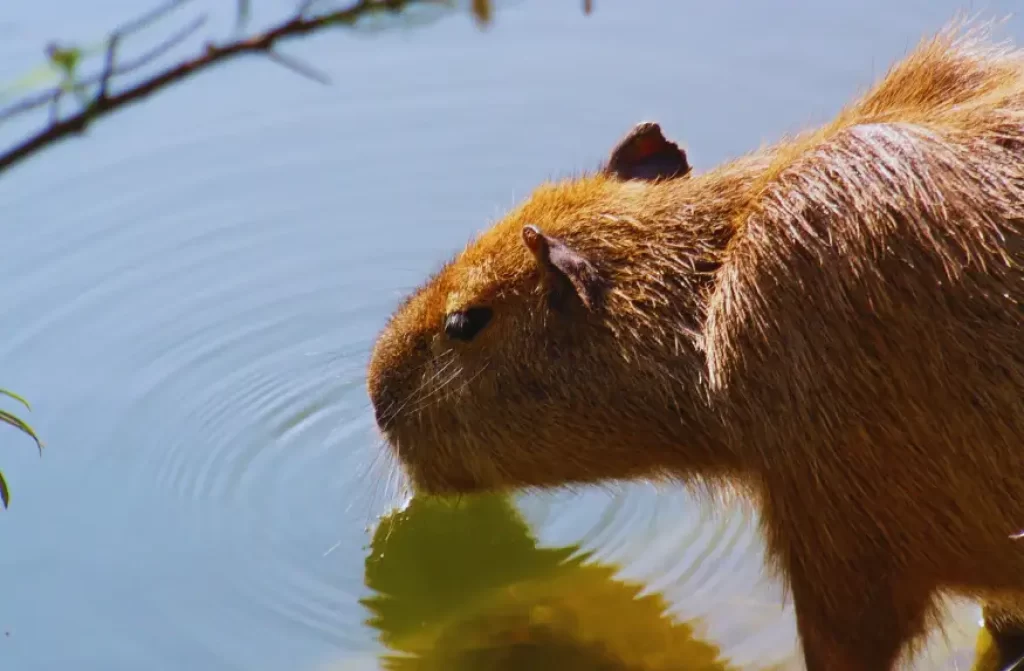
Adult capybaras typically measure around 3 to 4.5 feet (approximately 1 to 1.4 meters) in length. They stand about 1.5 feet (about 0.5 meters) tall at the shoulder. Capybaras can weigh anywhere between 77 to 146 pounds (approximately 35 to 66 kilograms).
Generally, males are larger and heavier than females. The average weight of capybaras in the Venezuelan llanos is around 48.9 kg (108 lb).
The heaviest recorded weight for a wild female capybara is 91 kg (201 lb) from Brazil, and for a wild male capybara is 73.5 kg (162 lb) from Uruguay. There have also been reports of even heavier individuals, such as an 81 kg (178 lb) capybara found in São Paulo.
Limbs, Feet, and Tail
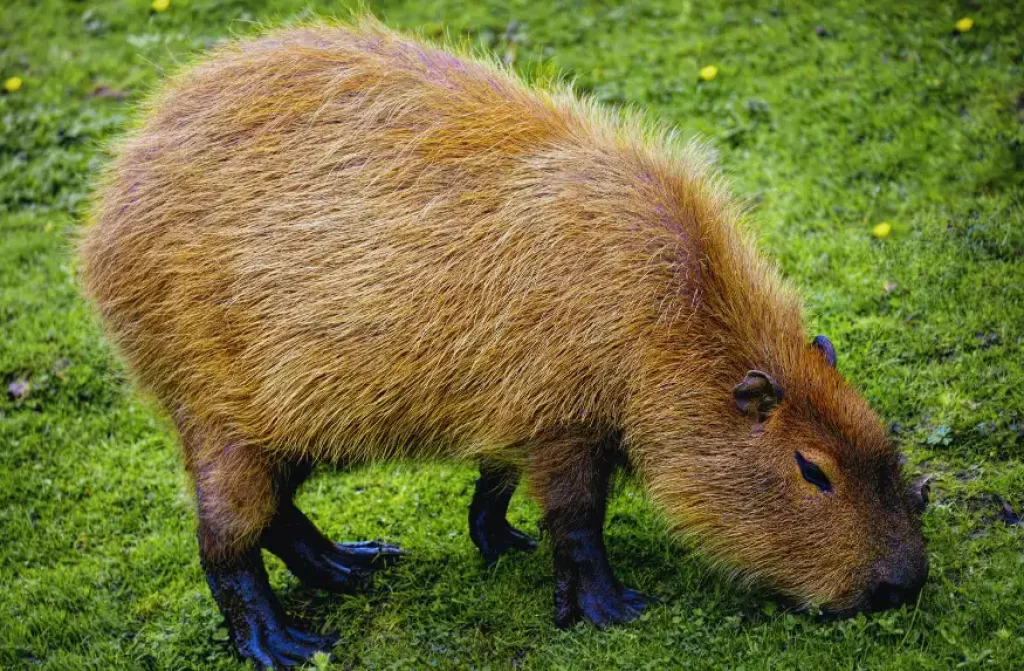
Capybaras have short, sturdy limbs and a slightly arched back. Their hind legs are somewhat longer than their forelegs. They have three toes on their rear feet and four toes on their front feet.
These feet are slightly webbed, which helps capybaras in swimming and navigating through water. They also have vestigial tails, meaning their tails are small and not fully developed.
Facial Features
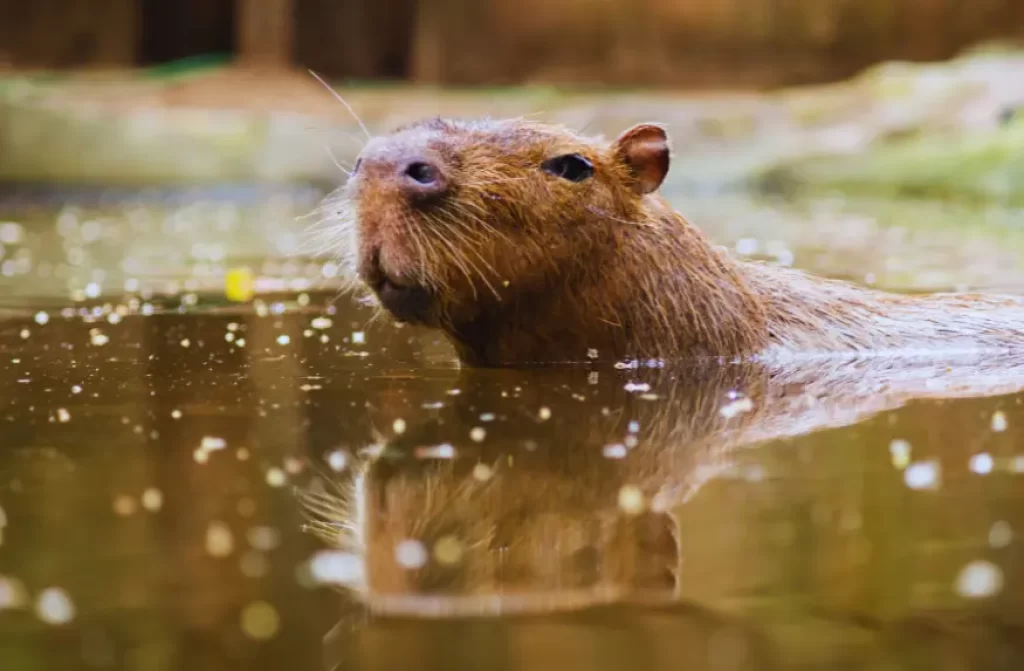
Capybaras possess a distinctive set of facial features. Their muzzle is characterized by a blunt shape, giving them a unique facial structure. The presence of nostrils allows capybaras to breathe efficiently, ensuring a steady supply of oxygen.
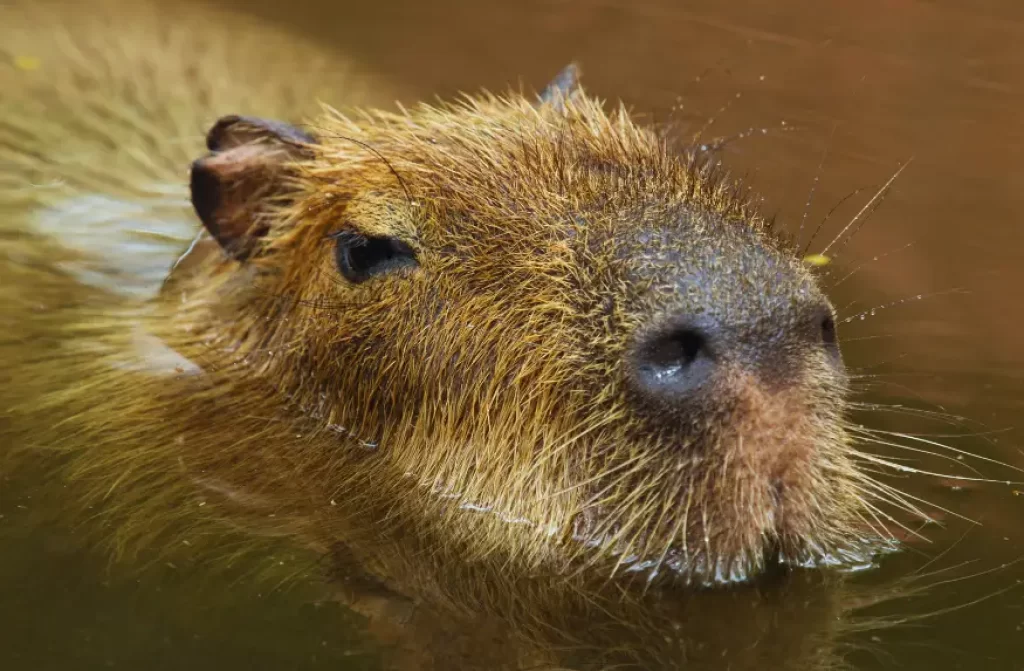
What sets capybaras apart is the placement of their eyes and ears. Positioned near the top of their heads, their eyes and ears provide an advantageous vantage point, particularly when capybaras are in the water.
This strategic positioning enables them to keenly observe their surroundings, allowing them to stay vigilant and swiftly detect potential environmental threats or changes.
Chromosomes
The karyotype of a capybara, which refers to the number and structure of its chromosomes, is 2n = 66 and FN = 102. This means that capybaras have 66 chromosomes in total, with a total of 102 arms. Chromosomes play a crucial role in an organism’s genetic makeup and inheritance.
Habitat and Distribution: Where do Capybaras live?

Capybaras have a diverse habitat range and are native to various regions of South America. They are well-adapted to both land and water environments, allowing them to thrive in various habitats.
Habitat Range of Capybaras
Capybaras exhibit a versatile habitat range, occupying diverse ecosystems across South America. They can adapt to various environments, including wetlands, savannas, forests, and grassy areas.
However, their preference lies in habitats near water bodies, such as rivers, lakes, and marshes.
Proximity to water plays a crucial role in capybaras’ habitat selection. These semiaquatic mammals are highly adept swimmers and take advantage of the aquatic resources available in their surroundings.
Water bodies offer them opportunities for swimming, cooling off, and accessing a plentiful supply of aquatic plants and vegetation, which constitute a significant portion of their diet.
Whether in wetlands, savannas, forests, or grassy areas, capybaras thrive when they have access to nearby water sources that provide both sustenance and a means to engage in their natural aquatic behavior.
Aquatic Lifestyle

Being semiaquatic mammals, capybaras are well-equipped to navigate and thrive in aquatic environments.
Their physical adaptations, such as their webbed feet and ability to close their ears and nostrils underwater, make them excellent swimmers.
Capybaras often take refuge in water bodies to escape predators or regulate their body temperature in hot weather.
Geographic Distribution
Capybaras are primarily found in South American countries. The largest populations can be found in Brazil, where they are abundant in various regions.
They are also prevalent in countries such as Venezuela, Colombia, Argentina, and Paraguay.
Capybaras occupy suitable habitats within these countries, including the Amazon rainforest, the Pantanal wetlands, and the Llanos grasslands.
Social Behavior

Capybaras are highly social animals that exhibit complex social behavior within their herds. Here is a breakdown of their social dynamics and communication methods:
Herd Structure
Capybaras live in large groups called herds. These herds can vary in size, ranging from around 10 to 100 individuals, although smaller family groups are more common.
Typically, a herd consists of two to four adult males and four to seven adult females; the remaining members are juveniles.
During the dry season, when water sources become limited, herds can gather in larger numbers, reaching up to 50 or even 100 individuals.
Social Bonds and Communication
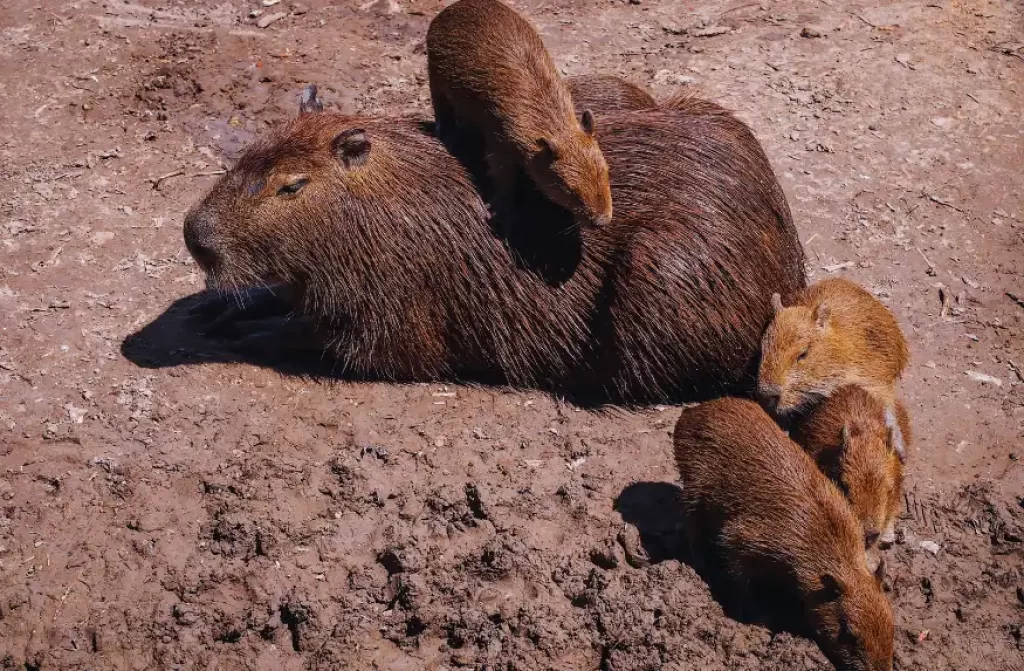
Social bonds within Capybara herds are strong. They engage in mutual grooming, which involves individuals grooming each other’s fur, reinforcing social connections, and maintaining hygiene.
Capybaras also utilize vocalizations to communicate with one another. They can emit dog-like barks as a warning signal when threatened or when females are herding their young.
Scent Glands and Marking Behavior
Capybaras have two types of scent glands: the morrillo, located on their snouts, and the anal glands.
Both males and females possess these glands, but males have larger morrillos and use their anal glands more frequently.
The anal glands of males are lined with detachable hairs coated with a crystalline form of scent secretion.
When capybaras come into contact with objects, they rub their morrillos or walk over scrub, leaving their scent through their anal glands.
This marking behavior establishes territorial boundaries and conveys information to other capybaras. Males also scent-mark females, particularly during the mating season.
Diet: What do Capybaras eat?

Capybaras are herbivores, feeding primarily on a variety of plants and grasses. They are known to consume large quantities of vegetation to meet their dietary needs. Their digestive system is specially adapted to extract nutrients from rigid, fibrous plant material.
Herbivorous Feeding
Capybaras are strict herbivores, relying on a wide variety of plants and grasses as their primary food source. They consume large quantities of vegetation to meet their nutritional needs.
Their diet includes grazing on grasses, feeding on aquatic plants, and occasionally consuming fruits and tree bark.
They display selective feeding behavior, often focusing on specific plant species while disregarding others in their surroundings.
Seasonal Variation
Capybaras exhibit dietary flexibility to adapt to changing seasons and the availability of food resources.
During the wet season, they primarily graze on grasses. However, during the dry season, when fewer grasses are available, capybaras switch to more abundant reeds for sustenance.
They show a greater variety of plant consumption during the dry season compared to the wet season.
Digestive Adaptations
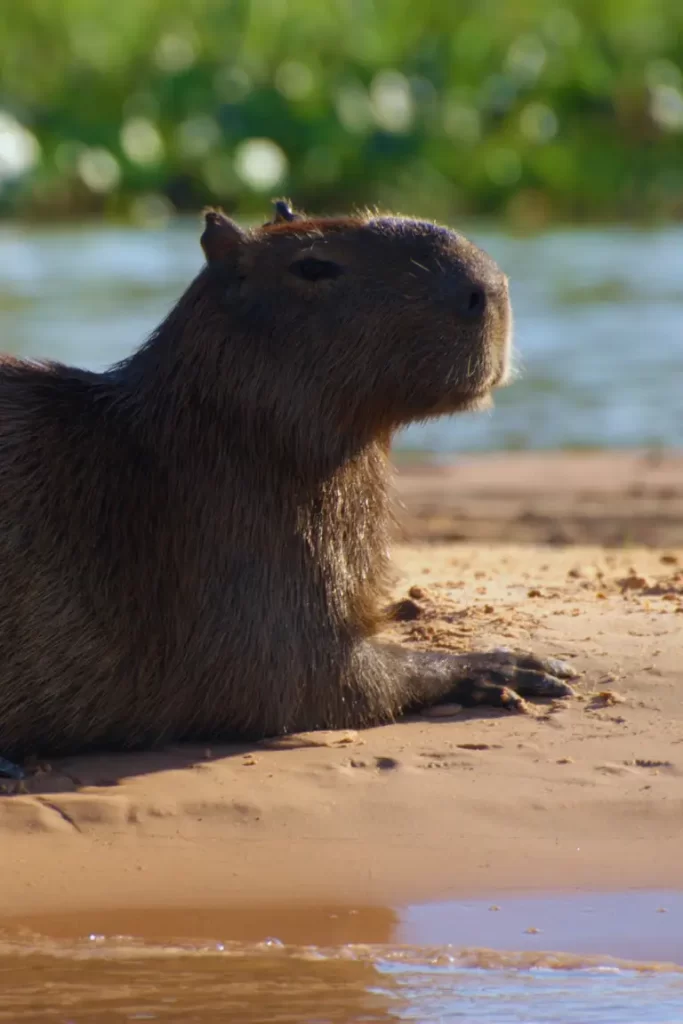
The capybara’s digestive system is specially adapted to extract nutrients from tough, fibrous plant material. Their jaw hinge is not perpendicular, enabling them to chew food by grinding back-and-forth rather than side-to-side.
Capybaras are auto-coprophagous, which means they consume their own feces as a way to acquire bacterial gut flora. This process aids in the digestion of cellulose in the grass that forms their primary diet and allows them to extract maximum protein and vitamins from their food.
They also engage in regurgitation and rechewing of food, similar to cud-chewing seen in cattle.
Dental Adaptations
As with other rodents, capybaras have continuously growing front teeth to compensate for the wear caused by eating grasses. Their cheek teeth also have continuous growth.
This ensures that their teeth remain effective tools for breaking down vegetation throughout their lifespan.
Note: Capybaras are strict herbivores that consume a variety of plants, grasses, and aquatic vegetation.
Reproduction
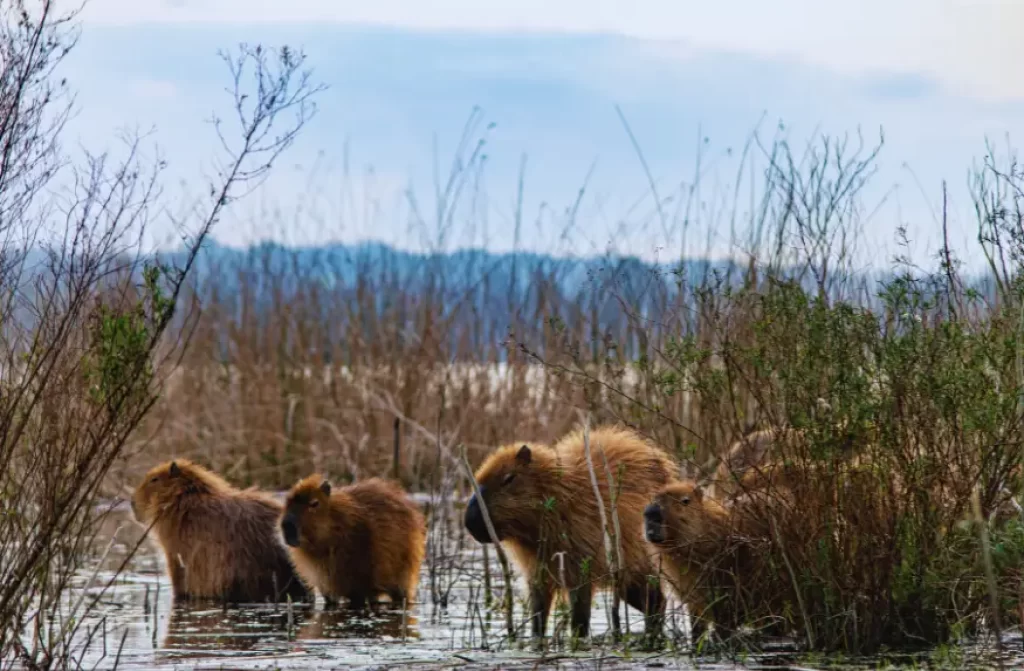
Like many other social animals, Capybaras have fascinating reproductive behaviors and adaptations that contribute to their successful breeding and survival. Let’s delve deeper into the various aspects of capybara reproduction:
Mating Behavior of Capybaras
During the breeding season, female capybaras experience subtle changes in their scent that signal their readiness to mate.
These changes attract the attention of nearby males, who begin pursuing the females. In addition to scent cues, females also emit distinct whistling sounds through their noses, acting as a further signal to indicate their estrus state.
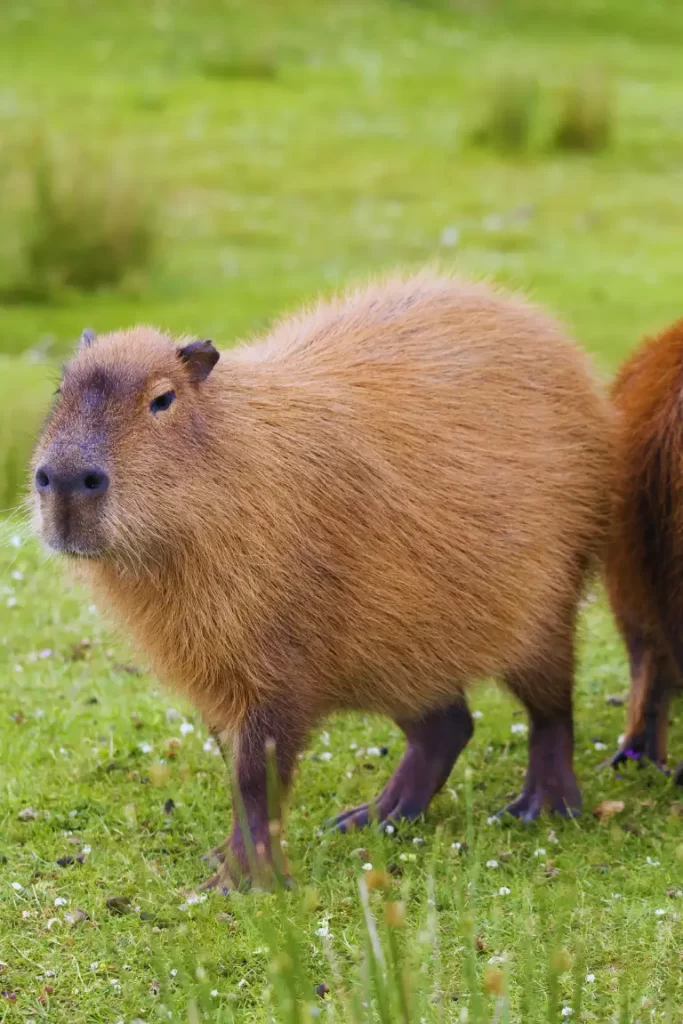
Mating in capybaras occurs exclusively in water, which is an essential aspect of their reproductive behavior.
If a female does not wish to mate with a particular male, she can submerge herself or leave the water, effectively avoiding unwanted advances. This gives the female capybara control over her mating choices.
In capybara social groups, dominant males play a significant role in breeding. They are highly protective of the females, ensuring their reproductive success.
However, it is challenging for a dominant male to monitor and guard all the females, especially in larger groups. This allows subordinate males to have opportunities to mate as well. While dominant males secure a higher number of matings individually, subordinate males collectively contribute to more matings as a group.
Capybara reproduction is unique in terms of sperm lifespan. The lifespan of capybara sperm is longer compared to other rodents. This adaptation may increase the chances of successful fertilization, even when mating occurs intermittently or infrequently.
Gestation and Birth
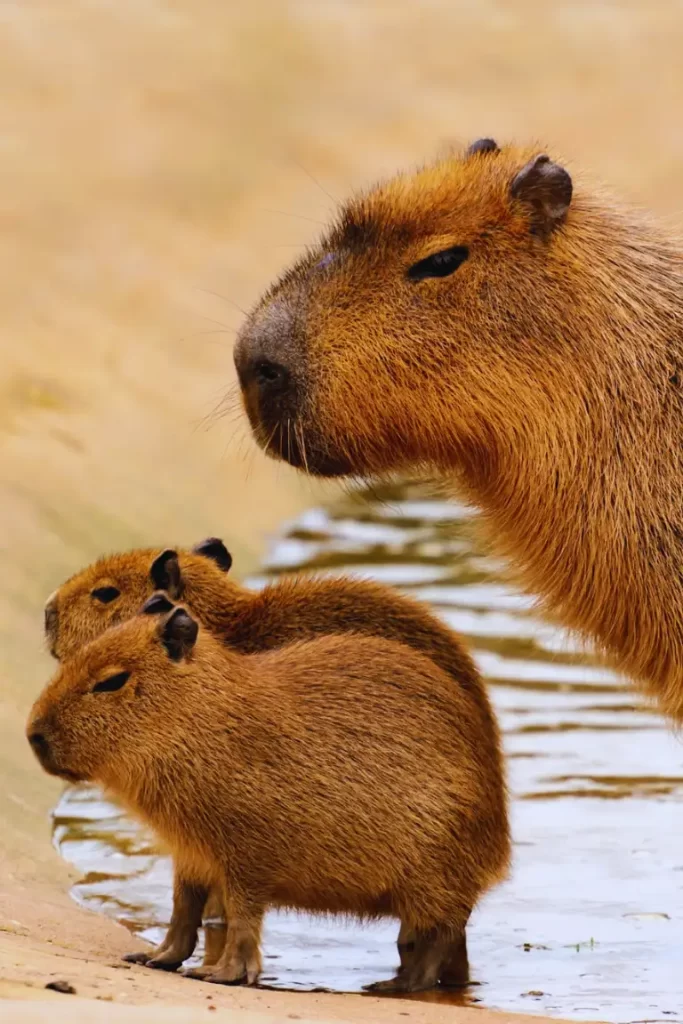
After successful mating, female capybaras undergo a gestation period that lasts approximately 130 to 150 days. When the time for birth approaches, the female capybara leaves the water and gives birth to a litter of young on land.
On average, a female capybara gives birth to about four offspring, but litter sizes can range from one to eight.
Remarkably, the female rejoins the group within a few hours of delivering the newborn capybaras. The young, known as pups, are quick to become mobile and soon join the group.
While the young capybaras start to graze on grass within a week, they continue to suckle from any lactating female in the group until they are weaned at around 16 weeks of age.
The formation of a subgroup within the main herd by the young capybaras has been observed. This subgroup provides an additional layer of social structure within the larger social group.
Conservation Status
The capybara is not currently considered an endangered species. However, habitat loss due to deforestation, hunting for meat and fur, and competition with livestock for resources threaten their populations in some regions.
Efforts are being made to protect their habitats and regulate hunting to ensure their long-term survival.
Fun facts about Capybaras
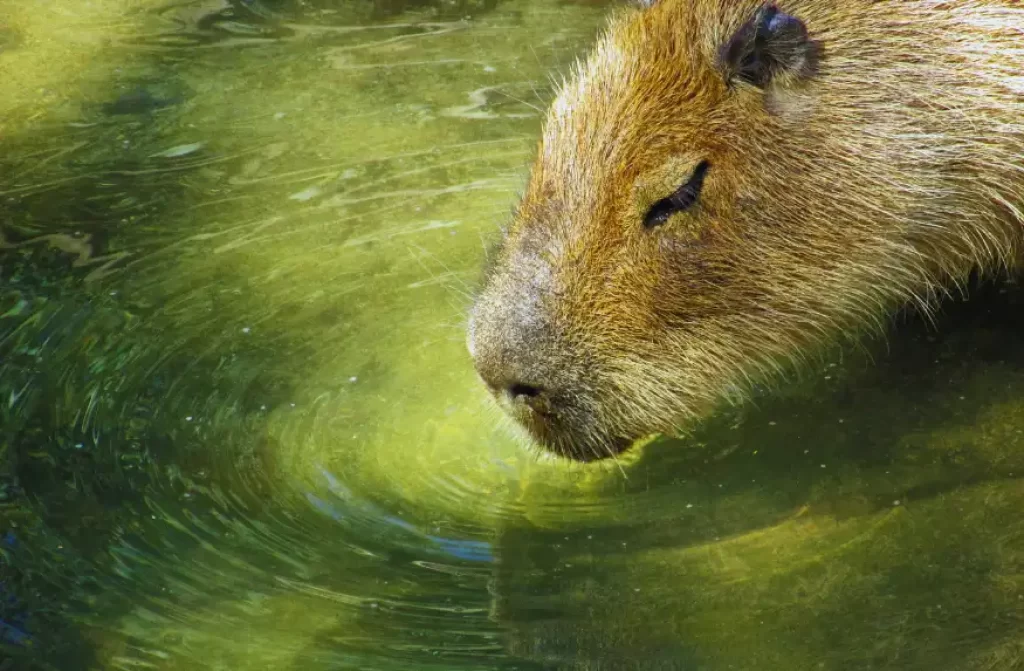
Capybaras, renowned for their friendly and tolerant nature, have a remarkable ability to coexist harmoniously with various animal species. Here are some intriguing details about their peaceful interactions:
Interacting with Birds
Capybaras are often seen sharing their habitat with different bird species. They display a remarkable level of tolerance, allowing birds to perch on their backs or swim alongside them. This behavior is not only fascinating to witness but also demonstrates the capybaras’ acceptance of other creatures in their environment.
Peaceful Encounters with Turtles
Capybaras and turtles can frequently be found basking in the sun together on riverbanks or floating side by side in the water.
Capybaras show no signs of aggression or territorial behavior towards turtles, showcasing their peaceful coexistence and willingness to share space.
Unusual Relationship with Caimans
In some instances, capybaras have been observed interacting with smaller crocodile species known as caimans.
Although caimans are natural predators, capybaras often exhibit a friendly rapport with them, swimming in close proximity without aggression or fear. This unique relationship is a testament to the capybaras’ non-confrontational nature.
Friendliness in the Animal Kingdom
Capybaras have gained a reputation as one of the friendliest animals in the animal kingdom due to their amicable behavior towards other species.
Their social nature, coupled with their calm demeanor, enables them to establish peaceful relationships with a diverse range of animals.
Frequently asked questions
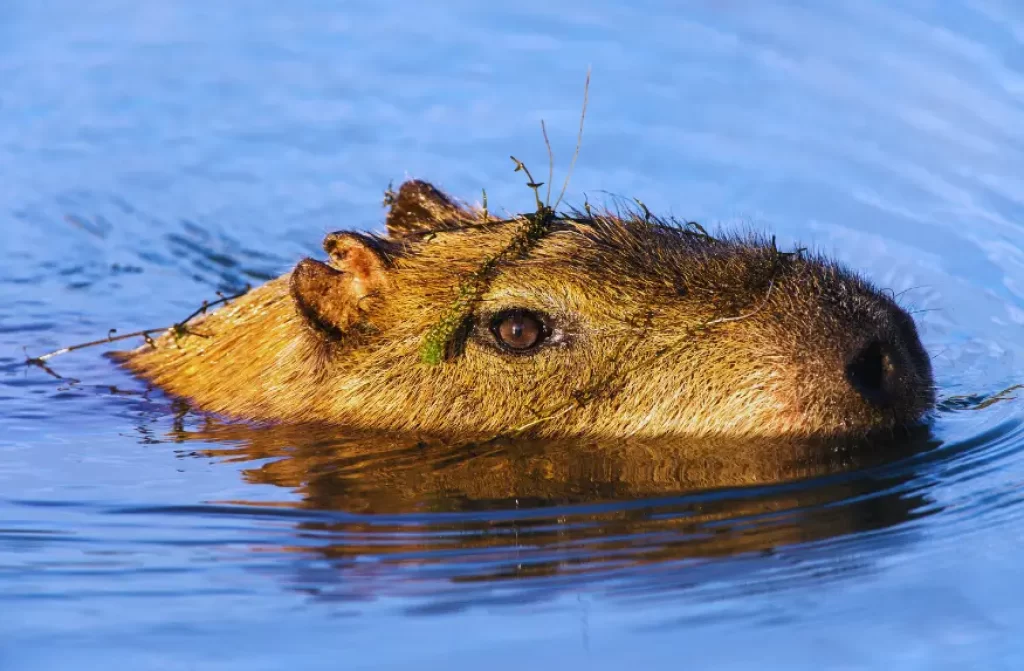
Do capybaras have tails?
Yes, capybaras do have tails, but their tails are relatively short and often referred to as vestigial. The tail of a capybara is typically around 10 to 20 centimeters (4 to 8 inches) in length. It is not as prominent or long as the tails seen in many other animal species.
The tail is covered in fur and is usually held close to the body, not serving a significant functional purpose.
While capybaras may use their tails for balance while moving through water or to communicate subtle body language cues, their tails are not a prominent feature of their overall physical appearance.
Do capybaras eat their own poop?
Yes, capybaras engage in a behavior known as coprophagy, which involves eating their own feces. This behavior is also observed in many other herbivorous animals and serves several important purposes.
When capybaras consume their feces, it allows them to obtain additional nutrients that were not fully extracted during the initial digestion process.
By re-ingesting their feces, capybaras can further break down and extract valuable nutrients, particularly proteins, and vitamins. This behavior is an adaptation that helps capybaras maximize the nutritional value they obtain from their herbivorous diet.
Coprophagy is a common behavior among many animals, and it serves as an efficient way to extract additional nutrients and maintain a healthy digestive system.
What do capybaras primarily feed on?
Capybaras are herbivores and primarily feed on a variety of plants and grasses. They also consume fruit and tree bark.
How do capybaras select their food?
Capybaras are selective feeders. They eat the leaves of certain plant species while disregarding others around them.
Do capybaras change their diet based on the seasons?
Yes, capybaras adapt their diet based on the availability of plants. During the wet season, they consume grass, while in the dry season, they switch to more abundant reeds.
Do capybaras have predators?
Yes, capybaras have natural predators in their native habitats. While they are large and social animals, they are not entirely immune to predation. Some of the main predators of capybaras include:
- Jaguars: Jaguars are apex predators in the regions where capybaras reside, such as the Amazon rainforest. They have the ability to ambush and overpower capybaras.
- Anacondas: Large constrictor snakes like the green anaconda, found in the same habitats as capybaras, are capable of capturing and suffocating capybaras in water or on land.
- Caimans: Caimans are smaller crocodile species that inhabit the same aquatic habitats as capybaras. While they primarily feed on fish, caimans can also prey on capybaras, especially juveniles or weakened individuals.
- Large Birds of Prey: Birds of prey such as eagles, hawks, and owls are capable of hunting and capturing capybaras, particularly younger or smaller individuals.
- Predatory Cats: Other big cats like pumas and ocelots may occasionally target capybaras, especially if they are vulnerable or isolated from their herd.
How do capybaras extract nutrients from tough plant material?
Capybaras have a specially adapted digestive system to extract nutrients from tough, fibrous plant material. They grind their food back-and-forth due to their jaw structure.
Do capybaras bite?
Yes, capybaras are capable of biting. While they are generally docile and peaceful animals, they may resort to biting if they feel threatened or provoked.
It’s important to remember that capybaras are wild animals, and even though they can be kept as pets in some regions, they still possess natural instincts that may lead to defensive behaviors like biting.
It is recommended to exercise caution and respect their boundaries when interacting with capybaras or any wild animal.







